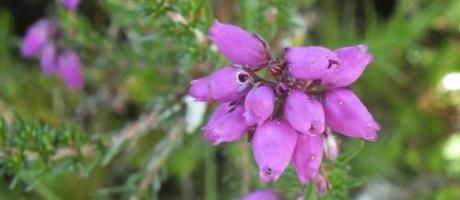I’ve been visiting family away from Cornwall for a while, so first of all apologies for not having posted for three weeks. But I’m back now, and I’ve been enjoying getting out and about in all this glorious sunshine. A little earlier this week, I went to visit some old haunts of mine on The Lizard – read on to discover what I found.
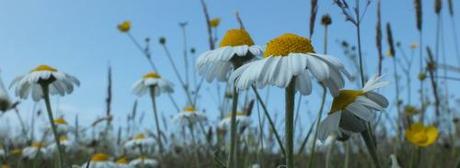
Scented carpets, ancient homes, flying boats and crackling gorse…a walk from Grochall to Lower Predannack, and back again
Over the summer of of 2010 I had the blissful task of surveying for rare plants on some of the trackways on The Lizard. The plants I was looking for were mainly opportunistic annuals that spring into action when conditions are right and competition from other plants is limited, and I was researching into how they were faring. It was interesting to study (as well as fairly idyllic spending so much time in beautiful surroundings in the name of work!), and I ought to explain more about it in a future post.
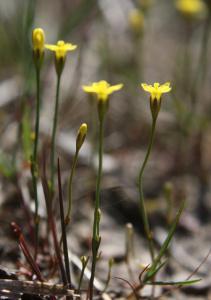
Yellow Centaury (Cicendia filiformis) on the Lizard Downs in 2010 (photo: Amanda Scott)
In the meantime, this week I thought I would pay a visit to a couple of the tracks I surveyed back in 2010 to see if I could spot one particular plant – Yellow Centaury – in locations where I know it appears. You can see this delightful, tiny plant, with its yellow flower that only opens in the sunshine, as early as the beginning of June on The Lizard in good years, but the bad weather earlier in 2013 put paid to that timing. However, with the complete turnaround in the weather, I thought I might be in luck. In the end, I only found two individual plants in separate places (hopefully the first of more), but I’ve given you a photograph from 2010 so you can admire its delicate beauty.
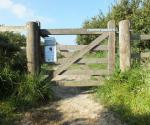
The gate to the Grochall Track (photo: Amanda Scott)
But even though I didn’t find much Yellow Centaury, there was plenty else to keep me interested on my way through the heathland. This is a nice walk, so I’ve tried to explain my route so you can follow it on a map if you’d like to try it yourselves.
I set off on my walk on the Grochall Track. This old trackway begins immediately to the south of the Kynance Garage (on the A3083 to Lizard Village). Walk a few metres along the public footpath, and you come to a gate that tells you that you have arrived at The Lizard National Nature Reserve. Enter, close the gate behind you, and start your journey…
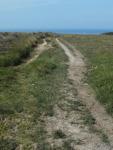
The Grochall Track – the older way to Kynance Cove (photo: Amanda Scott)
The Grochall Track has a long history. Until the early part of the twentieth century it was the main transport route to Kynance, crossing in a straight path across the Lizard Downs until it reaches the Cove itself. Now it is a sandy, rocky and sometimes grassy footpath, pretty boggy in the wetter months but dry and dusty in this hot weather. The track itself can seem a little bleak and dull at first glance, even on a sunny day: it is almost entirely straight, surrounded by flat heathland landscape, with the drone of cars passing on the A3083 behind you. The sea only appears on the horizon from about three-quarters of the way along the path. But it isn’t only interesting because of where it is leading…just look and listen…!
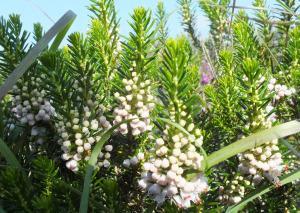
Cornish Heath (Erica vagans) by the Grochall Track (photo: Amanda Scott)
Ahead of me a solitary crow sat on a shrub, standing sentinel over the way to the west. Birds chattered in the gorse, making mad dashes across the path ahead of me. Butterflies (Small Heaths, Common Blues in hundreds) danced with each other through the bracken and grasses and across the heather. Ah yes – the heather! It was at the start of its season of glory, just beginning to bloom: Bell Heather (Erica cinerea), Cross-leaved Heath (E. tetralix), and the lovely Cornish Heath (E. vagans). I also found Lesser Water-plantain (Baldellia ranunculoides), another of the plants I surveyed for in 2010. This plant of water’s edges and boggy places has a fairly stable foothold in the west of Britain, but is declining elsewhere due to habit loss and eutrophication. Its species name of ranunculoides derives from the fact that its seedhead appears very similar to that of a buttercup (Buttercup family=Ranunculus), but it is in fact in a different family altogether.
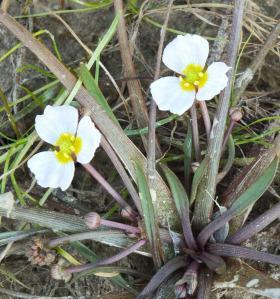
Lesser Water-plantain (Baldellia ranunculoides) (photo: Amanda Scott)
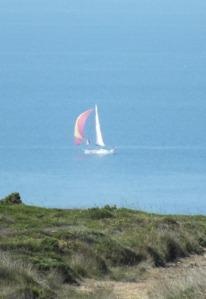
Sailing through Kynance (photo: Amanda Scott)
I didn’t go all the way to Kynance Cove, but instead turned right (north) to head towards the prehistoric village at Kynance Gate. Before I did so, I watched a yacht with one red and one white sail move across the Cove. In the heat haze it was hard to distinguish sea from sky at the horizon, and the boat could almost have been flying through the air, companion to the gulls of Asparagus Island.
I followed a rough stony track downhill until I reached the small wooden bridge across a stream at the entrance to the Kynance Farm, still part of the National Nature Reserve. Here I marvelled at dragonflies and damselflies, including a Broad-bodied Chaser and the quick weaving azure flight of two Beautiful Demoiselles.

Roundhouse at Kynance Gate prehistoric village (photo: Amanda Scott)
Go through the gate and the path bends to the left and upwards, but you can first detour here on to the much vaguer path to the right and head up the hill until you find the roundhouses of Kynance Gate prehistoric village. Occupied on and off between 1200BC and Roman times, the site was probably only used in the summer for grazing. They reminded me of those I visited at Bodrifty in my last post: quiet and empty of human life, but teeming with the hum of life that bees, butterflies and plants bring.
Returning to the main path at the gate to Kynance Farm, I made my way uphill until the path forks. The arrow points you to the right-hand fork so, of course, I went left (the paths rejoin each other in any case). Eventually you arrive at a large farm gate. To follow my route you need to go through the gate and turn right up a gravelled straight track, but first it’s important to take a moment (or several) to enjoy the view to the left, back to Kynance Cove across a field of low grass and wild flowers. At this time of year, the wild Chamomile is beginning to carpet the field and the apple-scent as you walk through the grass is uplifting.
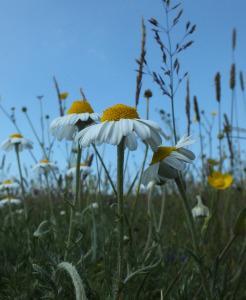
Chamomile field above Kynance (photo: Amanda Scott)
Back on the path and I was heading north towards Lower Predannack and Jolly Town Farm. A stream runs across the path just below Jolly Town, heading downhill towards Soapy Cove to the west, but here it pauses for a moment, forming a shallow pool even in the heatwave conditions, home to surface hopping insects and tadpoles.
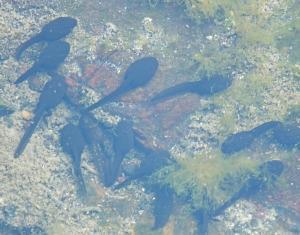
Tadpoles below Jolly Town (photo: Amanda Scott)
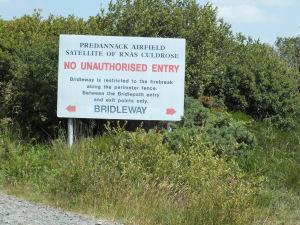
Entrance to the bridleway within the perimeter of Predannack Airfield. Turn right – don’t go straight on! (Photo: Amanda Scott)
Just beyond here, the track goes through a gate and becomes grassy, and you walk, still heading north, with the heathland to your right and a hedge to your left until you reach another gate and turn right up a surfaced path. A couple of hundred metres further and you meet a sturdy metal gate and this scary sign at the entrance to Predannack Airfield, linked to RNAS Culdrose. Never fear! – there is a public right of way (bridleway) within the perimeter of the airfield. Go right here and follow the path (another site for Yellow Centaury), which eventually turns left until you meet an equally scary sign and exit from the bridleway back on to the heath.
From here, it is a little difficult to explain, so please please please come armed with decent map and compass if you are following this route for the first time! On the OS map it looks easy – a clear path from the SE corner of the airfield, heading south-east past Die’s Pool (non-existent in the dry weather) until rejoining the Grochall Track and heading back to your starting point. On the ground…..well. That clear south-east track is very faint and overgrown over the heathland, and you end up in a hollow with a fence to your left, going through a gate into a wooded area, taking stepping stones over a small stream, out the other side through another gate, across a boggy patch (muddy even in this weather!), until thankfully picking up a clearer path back to the Grochall Track.

A Gorse pod – just popped! (Photo: Amanda Scott)
I’m less fond of this part of the route, I have to admit, probably because it’s at the end and I’m tired (I should try the walk the other way round, maybe!). This time, though, I was surprised by something unexpected. Just before going through that first gate to the wooded area, pausing to catch my breath and grumble at the bramble trailing across the path, I became aware of a constant crackling and popping from all around me. My first thought was wildfire…but suddenly there was a loud crack only inches away from me, making me jump! I realised I’d heard of this before but never experienced it – hundreds of Gorse pods popping open in the heat to display their shiny black fruit. It definitely made this ‘grumpier’ part of the walk worth the effort.
This walk is a good one if you want a mix of heathland, grassland and sea views, with a bit of archeology thrown in for good measure. If you want to make it longer, you can head further north and go all the way up to Predannack and Mullion before heading south again, either inland or on the coastal path, or you can divert to Kynance or Soapy Cove. Definitely have a good OS map, though, not just to show you all the trackways: if it gets misty (as it might in less clement weather), it’s easier than you think to get disorientated. Enjoy!
